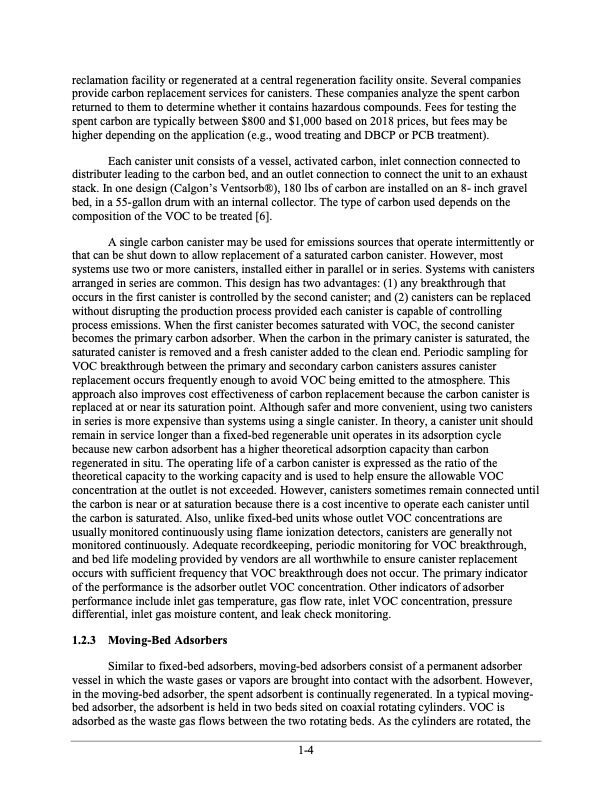
PDF Publication Title:
Text from PDF Page: 008
reclamation facility or regenerated at a central regeneration facility onsite. Several companies provide carbon replacement services for canisters. These companies analyze the spent carbon returned to them to determine whether it contains hazardous compounds. Fees for testing the spent carbon are typically between $800 and $1,000 based on 2018 prices, but fees may be higher depending on the application (e.g., wood treating and DBCP or PCB treatment). Each canister unit consists of a vessel, activated carbon, inlet connection connected to distributer leading to the carbon bed, and an outlet connection to connect the unit to an exhaust stack. In one design (Calgon’s Ventsorb®), 180 lbs of carbon are installed on an 8- inch gravel bed, in a 55-gallon drum with an internal collector. The type of carbon used depends on the composition of the VOC to be treated [6]. A single carbon canister may be used for emissions sources that operate intermittently or that can be shut down to allow replacement of a saturated carbon canister. However, most systems use two or more canisters, installed either in parallel or in series. Systems with canisters arranged in series are common. This design has two advantages: (1) any breakthrough that occurs in the first canister is controlled by the second canister; and (2) canisters can be replaced without disrupting the production process provided each canister is capable of controlling process emissions. When the first canister becomes saturated with VOC, the second canister becomes the primary carbon adsorber. When the carbon in the primary canister is saturated, the saturated canister is removed and a fresh canister added to the clean end. Periodic sampling for VOC breakthrough between the primary and secondary carbon canisters assures canister replacement occurs frequently enough to avoid VOC being emitted to the atmosphere. This approach also improves cost effectiveness of carbon replacement because the carbon canister is replaced at or near its saturation point. Although safer and more convenient, using two canisters in series is more expensive than systems using a single canister. In theory, a canister unit should remain in service longer than a fixed-bed regenerable unit operates in its adsorption cycle because new carbon adsorbent has a higher theoretical adsorption capacity than carbon regenerated in situ. The operating life of a carbon canister is expressed as the ratio of the theoretical capacity to the working capacity and is used to help ensure the allowable VOC concentration at the outlet is not exceeded. However, canisters sometimes remain connected until the carbon is near or at saturation because there is a cost incentive to operate each canister until the carbon is saturated. Also, unlike fixed-bed units whose outlet VOC concentrations are usually monitored continuously using flame ionization detectors, canisters are generally not monitored continuously. Adequate recordkeeping, periodic monitoring for VOC breakthrough, and bed life modeling provided by vendors are all worthwhile to ensure canister replacement occurs with sufficient frequency that VOC breakthrough does not occur. The primary indicator of the performance is the adsorber outlet VOC concentration. Other indicators of adsorber performance include inlet gas temperature, gas flow rate, inlet VOC concentration, pressure differential, inlet gas moisture content, and leak check monitoring. 1.2.3 Moving-Bed Adsorbers Similar to fixed-bed adsorbers, moving-bed adsorbers consist of a permanent adsorber vessel in which the waste gases or vapors are brought into contact with the adsorbent. However, in the moving-bed adsorber, the spent adsorbent is continually regenerated. In a typical moving- bed adsorber, the adsorbent is held in two beds sited on coaxial rotating cylinders. VOC is adsorbed as the waste gas flows between the two rotating beds. As the cylinders are rotated, the 1-4PDF Image | Carbon Adsorbers

PDF Search Title:
Carbon AdsorbersOriginal File Name Searched:
final_carbonadsorberschapter_7thedition.pdfDIY PDF Search: Google It | Yahoo | Bing
CO2 Organic Rankine Cycle Experimenter Platform The supercritical CO2 phase change system is both a heat pump and organic rankine cycle which can be used for those purposes and as a supercritical extractor for advanced subcritical and supercritical extraction technology. Uses include producing nanoparticles, precious metal CO2 extraction, lithium battery recycling, and other applications... More Info
Heat Pumps CO2 ORC Heat Pump System Platform More Info
| CONTACT TEL: 608-238-6001 Email: greg@infinityturbine.com | RSS | AMP |